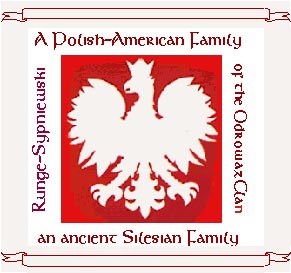
 The Music playing is Chopin's Waltz in AB, Opus 68, No1 ("L'Adieu")
The Music playing is Chopin's Waltz in AB, Opus 68, No1 ("L'Adieu")from The Chopin Page
Polish Manor Houses
Researched and written by Margaret Odrowaz-Sypniewska

L~azienski Palace was known as "the Palace Upon the Water." In the sixteenth century, this estate, and palace, belonged to Stanislaw Herakliusz Lubomirski*, Grand Marshal of the Crown.
"During the early 17th century,the Polish-Lithuanian Commonwealth had a population of over nine (9) million and occupied the greatest territory in it's history - 990,000 square kilometers. This period brought prosperity to the magnates, and the estates of several noble families greatly increased in size - notably those of the Zamoyski, Ostrogski, Zasl~awska, Wisniowieckim and Lubomirski families"(Banaszak, 49).
Later on L~azienski was identified with King Stanislaus Augustus Poniatowski, its greatest patron. It was then noted for its Thursday lunches, to which Poniatowski invited famous literati of the era (Banaszak ).
Stanislaus Heraklius Lubomirski was born in 1642, and died January 17, 1702 at Ujazdow. He belonged to the clan Sreniawa. He was the Crown Marshall (in 1673), a poet, and a political writer. His father was George Sebastian Lubomirski. During the Lubomirski rebellion of 1665-1666, Stanislas sided with his father. Thus, in 1669, he obtained the suppression of a judgment for the disposition against his father. Stanislaus H. Lubomirski was a supporter of Michael Korybut Wisniowiecki, and concurred with his policies aspiring to be Poland's next king. In 1676, he consulted with the king's dissidents, prior to the election of the Royal Prince Jacob as king (1692-1693). Lubomirski was opposed to the Sapiezynski plot to overrule the king's coalition. After the death of John III Sobieski, Stanislas Lubomirski was an advocate of Father Cortiego's candidates. He was an author of pastoral and comedic verses, casual verse, religious verse, and a political treatise called De Vanaitate Consilliorum" in 1699. Other works were: Conversations of Artakes and Evandra (1683) and Deep Characteristics of Philosophical Reflections of Cynical Enslavement(Dziegielewskui, Jan, Ekes, Janusz,[et al]. Encyklopedia Historii Polski: Dzieje Polityczne. Warsaw: Morex s.c.-Egross,1994, 392).
Translated by Leonard Suligowski
In the Middle Ages, there was a stronghold, of the princes of Mazovia, on a sandy escarpment on the Vistula River. The stronghold was on the grounds of the present L~azienki Palace. Although archeologists can't place the exact location of the fortress, they do know it was on the surrounding land. In the Middle Ages, this stronghold was called Jazdów. It was captured by the Lithuanians and Ruthenians in 1262. Prince Siemowit I died at this battle. The stronghold was then rebuilt, only to be destroyed again in 1281, as a result of the feuding between Conrad II and Boleslaus II. Jazdów was renamed Ujazdów, and it was a hunting place.
Bona Sforna, wife of King Sigmund I, lived at Ujazd Palace from 1548. A large wooden house was built in 1606 by Allessandro Albertina for Anne Jagiellon, daughter of Bona Sforna.
In 1578, the palace was the place chosen for the wedding of Jan Zamoyski and Krystyna Radziwill. Anne Jagiellon built the original Belvedere Palace in 1596, near the village of Ujazd.
In 1624, King Sigusmund III Vasa built a new brick castle here, which was commissioned to Matteo Castelli and Constante Tencalla, who also built the Royal Castle in Warsaw, Poland.
During the Polish-Swedish War (1656-1657), the castle was plundered and for a time the mint was located here. Ujad Castle passed to Teodor Denhoff, who ceded it to his son-in-law, Stanislaw Herakliusz Lubomirski (in 1674), Grand Marshal of the Crown. At this time, the grounds were expanded and new buildings were built.
In 1720, Ujazd was leased to Augustus II, King of Poland, and Elector of Saxony. Augustus again upgraded this estate.
* 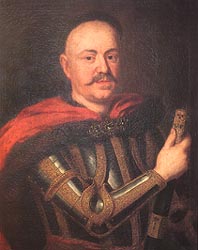 ...........
...........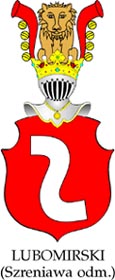
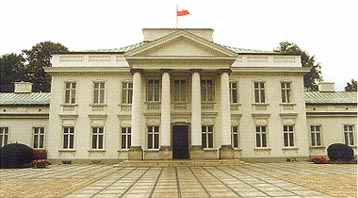
In 1764, Stanislaus Augustus Poniatowski became the king and a new era began at Ujazdów, Lazienki and the Belvedere. He reconstructed Ujazd Castle, and made the Bath House his "Summer House," while working on improving the grounds and animal reserve. Either August Moszynski or Schroeger did this reconstruction. Part of this project included the building of the Royal Porcelain Factory in the Belvedere. On December 30, 1768, the factory was opened, and its director was Franz Joseph Schütter, a Bavarian. This endeavor was far from successful, so they changed production to coarser pottery (most likely stoneware). This stoneware was known as Belvedere faience*. They produced a 160 piece dinnerware set for the Sultan Abdul Hamid (of Turkey) in 1777. Pottery marked "Varsovie," with the letter "B," was popularly known as "belvederes," and they were successful and highly artistic.
*Faience is a fine variety of pottery with highly colored designs. The name faience came from the original pottery of this type that was produced in Faenza, France. The Belvedere form was modelled in both form and decoration to Eastern porcelain. The Belvedere faience was made primarily for the court. After the Bath House was converted to a summer palce, a White Cottage was built for Poniatowski's guests. This was complete after 1778, and was designed in the neo-classical style.

Then Poniatowski began the Myslewice Palace (1775-1778), the Orangery, the Theater, and other changes. People who frequented the estate were often the family of Poniatowski, and included Elzbieta Grabowski (his wife), Izabela Branicka (his sister), Ludwika Maria Zamoyska, and Teresa Hurula nee Kinska (widow of Andrzej Poniatowski, and mother of Prince Josef Poniatowski). They enjoyed the beauty and seclusion of this place. They had theatrical troupes that performed in their theater (in Ujaz Castle), they paddled on the canal, and enjoyed the palace's gardens and animal reserve.
In 1788, the Bath House pavilion was fully transformed into a palace and four years lated it was expanded again. The new additions were to the sides (off the isalnd) and were joined to the main structure by small bridges. After the death of the king, the property went to Prince Jozef Poniatowski. In 1801-1804, the Comte de Lille, Louis Bourbon, brother of Louis XVI, spent his summers at the estate.
In 1808, Prince Jozef handed L~azienki over to Onufry Kicki, the King's Chamberlain. After the death of Prince Josef, the estate passed to Maria Teresa Tyszkiewicz. In 1817, Maria sold L~azienki to tsar Alexander I. For the next one hundred years the palace and grounds belonged to the tsars of Russia.
In 1918, the Belvedere was made the residence of the Chief of State, Marshal Jozef Pilsudski.
In 1921, under the Treaty of Riga, most of the palace's art was returned, by the Russians, and alterations (made by the tsars) were changed back.
In 1935, after Pil~sudski's death, a museum was dedicated to him and was housed in the Belvedere.
In 1940, the Germans tore down the Chopin memorial and used it for scrap.
In 1944, the Germans burned the Palace on the Lake, by pouring gasoline all over the interior. They planned to dynamite the entire structure, but did not have time (luckily). After the second world war, the rebuilding was begun by Jan Dabowski and Marek Kwiatkowski (interior restorations). The re-building took seventeen years. The Belvedere remained the official residence of State.
Today L~azienki is a tourist attraction with restaurants, a gift shop, and game reserve.
A memorial to Frederic Chopin, designed by Woclaw Szymanowski, again stands in the park on Ujazdowie Ave. Free public concerts of Chopin's music are given there in the summer months.
Source: Kwiatowkowski, Marek and Krzysztof Jablonski (photographer). L~azienki: The Palace and Park. Warsaw, Poland: Interpress Publishers, 1995. ISBN 83-223-26622-x.
Currently available from Polarts. Click on "albums."
RELATED LINKS:
Castles and Palaces of Poland - Mazovia ... Lazienki Park, Warsaw, Poland ... A Visit to L~azienki Park (photos) ... Lazienki Palace in Moonlight by Zygmunt Vogel
<>
Today, now that Poland is again free of foreign influences, many Poles, of means, are buying up real estate and restoring manor houses to their former beauty. One book that discusses this process, and all the red tape involved, is:
Full Circle: A Homecoming to Free Poland by Radek Sikorski. This book was published by Simon & Schuster (New York) in 1997. Unfortunately this book is presently out-of print. But can be found on Amazon.com in limited quantities.

Radek Sikorski was born in Poland in 1963. He played an active role in Solidarity and was granted political asylum in Britain in 1982. His manor house (dwór) was called Chobielin, and it was owned by a German family at the turn of the century. They were reputed to have gone bankrupt at the end of World War One. The house had a few thousand acres and it sold for a small price, at this time. After the Communist liberation in 1945, his mansion (called Chobielin) was owned by the Interior Ministry. It was in ruins for many years until December 1981, when marshal law was imposed. The mansion was located in Bydgoszcz. It was sold for 6,849,899 old zlotys. A dollar, at this time was valued at 5,500 zlotys. So the house was sold for the equivalent of under one thousand English pounds in 1989. However, the house was still occupied, and this was only one of the many trials and tribulations involved in the process of restoration. An interesting read!
OTHER SOURCES:
ANOTHER SIKORSKI ARTICLE:
How We Lost Poland: Heroes Do Not Make Good Politicians An article by Radek Sikorski.
ANOTHER LUBOMIRSKI MANOR HOUSE:
This page was last updated on August 21, 2005
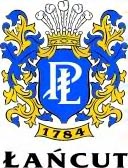 ...
... 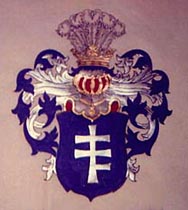
©Drawing (right) by Heraldry Artist - Leonard Suligowski
View My Guestbook
Sign My Guestbook
visitor since May 24, 2002
Owner: Raymond Sypniewski, B.S., M.A.
Email Margaret:
Margaret